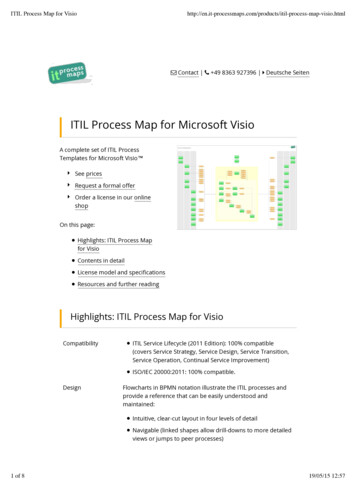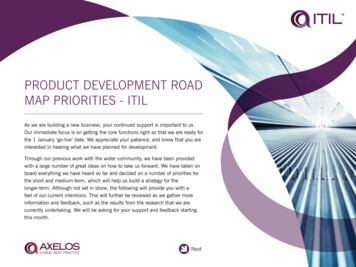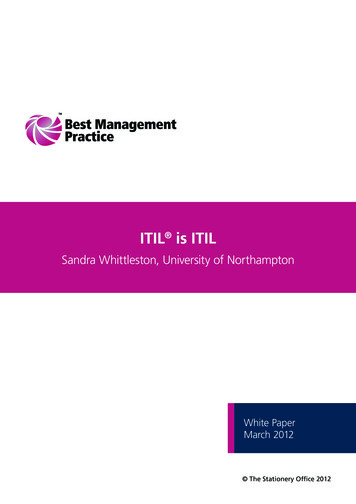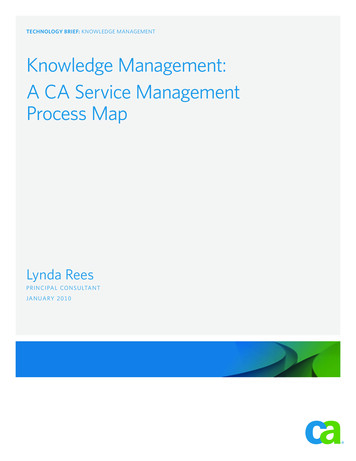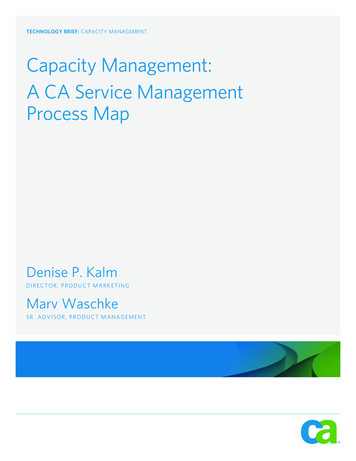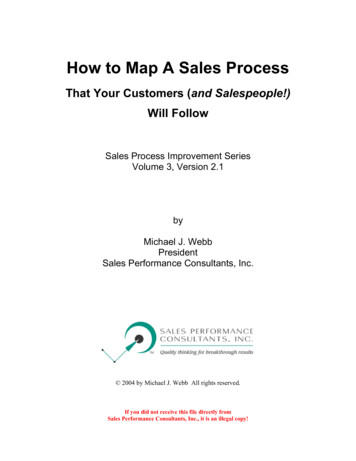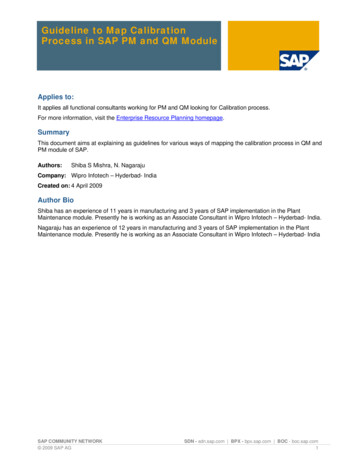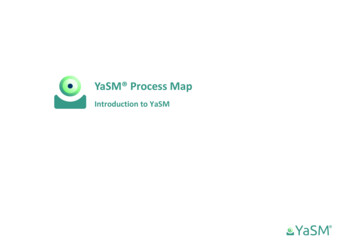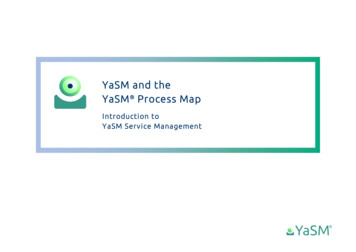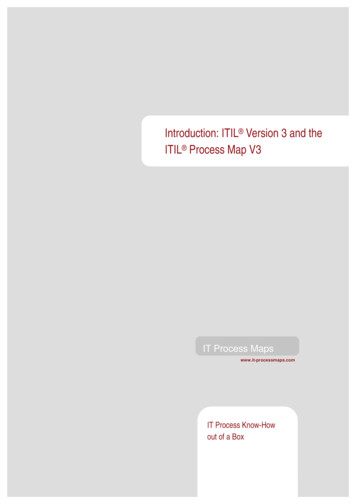
Transcription
Introduction: ITIL Version 3 and theITIL Process Map V3IT Process Mapswww.it-processmaps.comIT Process Know-Howout of a Box
IT Process Maps GbR, 2009-2-
ContentsHISTORY OF ITIL . 4The Beginnings. 4Recognition as a Standard . 4New Version in 2007: The ITIL V3 Service Lifecycle. 4THE ITIL V3 SERVICE LIFECYCLE . 5ITIL Main and Sub-Processes . 6ITIL Core Principles . 7HOW THE ITIL PROCESS MAP WAS CREATED FROM THE ITIL BOOKS . 9Differences between a Book and a Process Model. 9Where the ITIL Process Map goes beyond the ITIL Books . 10Processes vs. Functions. 14ITIL VERSIONS 2 AND 3. 15When to Switch from ITIL V2 to ITIL V3 . 15How to Achieve the Switch to ITIL V3 . 15DETAILED COMPARISON BETWEEN ITIL V2 AND ITIL V3 . 16General Differences. 16Differences and Changes: Service Strategy. 17Differences and Changes: Service Design. 18Differences and Changes: Service Transition . 20Differences and Changes: Service Operation . 22Differences and Changes: Continual Service Improvement. 24ITIL AND ISO 20000 . 25How ITIL and ISO 20000 are Related . 25Key ISO 20000 Requirements. 25ISO 20000 Requirements in Relation to ITIL Processes . 26 IT Process Maps GbR, 2009-3-
History of ITILThe BeginningsITIL was developed at the end of the 1980's by the CentralComputing and Telecommunications Agency (CCTA), agovernment agency in Great Britain. The reason forcommissioning the CCTA was a lack of quality of the ITservices procured by the British Government, so that amethod had to be found to achieve better quality andsimultaneously decrease their costs. The objective was todevelop effective and efficient methods for the provision of ITServices - in other words a catalogue of best practices for theIT organization, which today is known as ITIL.The essence of the methods is to make IT services explicitand strictly focused on client needs. This is combined withclearly defined responsibilities for the service provision withinthe IT organization and effectively designed IT processes. Asa result, the IT organization concentrates on the servicesrequired by the business, rather than being focused ontechnologies.The recommendations thus compiled are very broadlyvalid. It was found that the requirements of the businessesand organizations examined by the CCTA were mostly similar,independent of their size or industry sector.A series of books on ITIL has been issued since 1989 bythe Office of Government Commerce (OGC), anadministrative body of the Government of Great Britain whichis the successor of the CCTA. ITIL is a registered trademarkof the OGC.Recognition as a StandardIn the past years, ITIL has become the de-facto standardfor IT Service Management. Increasingly, IT managersdeveloped awareness for the service- and customer-drivenapproach championed by ITIL, and the ITIL terminology iswidely understood and used.The ITIL philosophy has found its way into a multitude ofother models related to IT Service Management, as forexample: IT Process Maps GbR, 2009-4-— ISO 20000 (formerly BS 15000): Information Technology Service Management— HP ITSM Reference Model (Hewlett Packard)— IT Process Model (IBM)— Microsoft Operations FrameworkNew Version in 2007: The ITIL V3 ServiceLifecycleIn 2007 the OGC published a completely revised version ofITIL, known as “ITIL Version 3 (ITIL V3)”.ITIL V3 reflects the experiences gained with the earlierversions and puts a greater emphasis on creating businessvalue. In comparison to ITIL V2 - which consisted of ninebooks - it is more streamlined around a set of five new corepublications which together form the “ITIL V3 ServiceLifecycle”:— Service Strategy— Service Design— Service Transition— Service Operation— Continual Service ImprovementThe rationale for organizing the ITIL books in this way wasto establish a Deming-like Plan-Do-Check-Act cycle focusedon continual improvement.Overall, ITIL V3 complements the processes known fromITIL V2 with a number of new processes and puts moreemphasis on producing value for the business. The underlyingprinciples are largely unchanged.The following chapter presents an introduction into the ITILV3 Service Lifecycle. More detailed information on thedifferences between ITIL V2 and V3 can be found furtherbelow (see chapter “ITIL Versions 2 and 3” on page 15).
The ITIL V3 Service LifecycleThe ITIL V3 Service LifecycleServiceStrategyService Strategyi iService PortfolioiService DesignRequest for Change(RFC)i iService DesignPackage (SDP)iServiceTransitionService LevelAgreement (SLA)i iOperational LevelAgreement (OLA)iServiceOperation SuggestedChanges to SLAs,OLAs and UCsiiSuggested ProcessImprovementsiContinualServiceImprovement The Service Lifecycle is about managing services fromtheir creation to retirement. Each of the five core elements isfocused on a specific phase of a service’s lifecycle:ii— Service Transition builds and deploys new or modifiedservices— Service Operation carries out operational tasks— Continual Service Improvement learns from pastsuccesses and failures and continually improves theeffectiveness and efficiency of services and processes.— Service Strategy determines which types of servicesshould be offered to which customers or markets— Service Design identifies service requirements anddevises new service offerings as well as changes andimprovements to existing ones IT Process Maps GbR, 2009ServiceImprovement Plan(SIP)-5-
ITIL Main and Sub-ProcessesThe ITIL Process Map allows exploring the ServiceLifecycle processes in a top-down manner. The example onthis page shows why this is ideal for getting familiar with theITIL processes:— The High Level View shows the ITIL V3 Service Lifecycleand its most important external relationships on one singlepage— Zooming in by clicking the corresponding process object,the viewer is presented an overview of the ServiceTransition process. This diagram illustrates what ServiceTransition is about: It includes all sub-processes with theirinterrelationships, as well as all the interfaces toprocesses outside of Service Transition.— Zooming in once again leads to an overview of ChangeManagement — and finally to a detailed process flow for the “ChangeAssessment by the CAB” process, which also includes acomplete list of inputs and outputs, and linked checklists/document templates.Level 0: High Level View ofITIL V3Level 1: ITIL Core DisciplineLevel 2: ITIL Main ProcessLevel 3: Process Chain IT Process Maps GbR, 2009-6-
ITIL Core PrinciplesThe ITIL Process Map consistently adheres to twoimportant ITIL principles. Having these in mind will help tounderstand each process’s meaning within the ITIL ServiceLifecycle.Structure of AgreementsThe layered structure of ITILagreements ensures that the ITorganization is aligned with thebusiness needs:— Service Level Agreements(SLAs) define the servicerequirements from thebusiness perspective— Operational LevelAgreements (OLAs) andUnderpinning Contracts(UCs) make sure that thoseservice requirements arematched from within the ITorganization IT Process Maps GbR, 2009-7-
Triggers for ActionAll of an IT organization’s activities should be strictlyfocused on providing business services as required by thecustomer. As a consequence, there is only a limited number ofevents which can trigger the introduction of a new service orthe modification of an existing one:— A new service is required, eitherbecause a customer is requestingit or because Service PortfolioManagement decided that a newservice must be created— Service levels which are alreadyagreed cannot be achieved – inthis case the service must beredesigned to fulfill thecommitments— Better ways to provide a servicebecome available, for example inthe form of new technologies orimproved external service offerings– the service will be redesigned insuch cases to make it moreeconomical IT Process Maps GbR, 2009-8-
How the ITIL Process Map was Created from the ITIL BooksOur decision to create the ITIL Process Map was basedon the insight that books are not ideally suited to describecomplex bodies of knowledge - like ITIL. Hence, the ITIL Process Map takes a different approach to presenting ITILBest Practice in the form of a clearly structured and layeredReference Process Model. It provides overview diagrams toillustrate the ITIL big picture and allows drilling down intodetails where necessary.Differences between a Book and aProcess ModelThe new set of ITIL books contains some 2000 pages ofBest Practice recommendations, while our Reference ProcessModel consists of about 20 overview diagrams and some 100detailed process flows, plus more than 60 checklists andtemplates. The ITIL Process Map is therefore not so muchabout presenting every single detail in a different format –rather, it depicts the essential contents in an easily accessibleand understandable way.A Reference Process Model is also subject to stricter rules.By definition, it must explicitly state which activities are to becarried out in what order, and what outputs are to be producedfor subsequent processes. Redundancies are not allowed –any activity occurs only once within a well-defined process,with clearly assigned responsibilities for its execution.Books, in contrast, can get away with being less strict.Statements like “Risk must be analyzed and managed duringall stages of Service Transition” are perfectly suitable forbooks. When developing a process model, however, it mustbe precisely defined how and when risks are analyzed andwho is responsible for the execution.In short, creating the ITIL Process Map meant extractingthe essentials from the ITIL books, sorting out redundancies,and translating the text-based content into clear-cut activityflows. This required a lot of expertise and effort - the presentversion 3 of the ITIL Process Map took us about 2 years todevelop. IT Process Maps GbR, 2009-9-
Where the ITIL Process Map goesbeyond the ITIL BooksWhile we followed the books as closely as possible, wedecided in some instances to introduce improvements whichassign clear responsibilities and make it easier to implementthe processes:Alignment of Processes: ITIL V3 Books and the ITIL Process Map V3Processes from the"Official itSMFOverview of ITIL V3"Processes within theITIL Process Map V3IDService StrategyService Strategy1Service PortfolioManagementService PortfolioManagement1.1Strategy Generation--Strategy Generation is treated as part of Portfolio Management.Demand Management--The chapter on Demand Management in the Service Strategybook does not offer enough substance to justify a separateDemand Management process and a dedicated DemandManager role. At the same time, the Capacity Manager is wellplaced to perform those activities. The approach to influenceservice demand in the ITIL Process Map is as follows: TheCapacity Manager id
Introduction: ITIL Version 3 and the ITIL Process Map V3 IT Process Know-How out of a Box IT Process Maps www.it-processmaps.com
